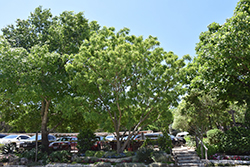It's all about ...
plants

Height: 25 feet
Spread: 20 feet
Sunlight:
![]()
![]()
Hardiness Zone: 8b
Description:
This highly ornamental small tree bears cluster of beautifully scented white pea-like flowers in early spring; flowers and wood have a strong vanilla-cinnamon scent; light, sea green compound leaves turn gold in fall; a stunning landscape accent
Ornamental Features
Arroyo Sweetwood features showy clusters of fragrant white pea-like flowers with deep purple calyces at the ends of the branches from early to mid spring, which emerge from distinctive buttery yellow flower buds. It has attractive bluish-green deciduous foliage. The small oval pinnately compound leaves are highly ornamental and turn an outstanding gold in the fall. The fruits are showy light green pods which fade to tan over time, which are displayed from late summer to late fall. The furrowed dark brown bark adds an interesting dimension to the landscape.
Landscape Attributes
Arroyo Sweetwood is a multi-stemmed deciduous tree with a more or less rounded form. Its relatively fine texture sets it apart from other landscape plants with less refined foliage.
This is a relatively low maintenance tree, and should only be pruned after flowering to avoid removing any of the current season's flowers. It is a good choice for attracting birds, bees and butterflies to your yard. Gardeners should be aware of the following characteristic(s) that may warrant special consideration;
- Self-Seeding
Arroyo Sweetwood is recommended for the following landscape applications;
- Accent
- Shade
- Hedges/Screening
Planting & Growing
Arroyo Sweetwood will grow to be about 25 feet tall at maturity, with a spread of 20 feet. It has a low canopy with a typical clearance of 4 feet from the ground, and is suitable for planting under power lines. It grows at a fast rate, and under ideal conditions can be expected to live for 60 years or more.
This tree does best in full sun to partial shade. It is very adaptable to both dry and moist growing conditions, but will not tolerate any standing water. It is considered to be drought-tolerant, and thus makes an ideal choice for xeriscaping or the moisture-conserving landscape. It is not particular as to soil pH, but grows best in sandy soils. It is highly tolerant of urban pollution and will even thrive in inner city environments. Consider applying a thick mulch around the root zone in both summer and winter to conserve soil moisture and protect it in exposed locations or colder microclimates. This species is not originally from North America..
This plant is not reliably hardy in our region, and certain restrictions may apply; contact the store for more information.
